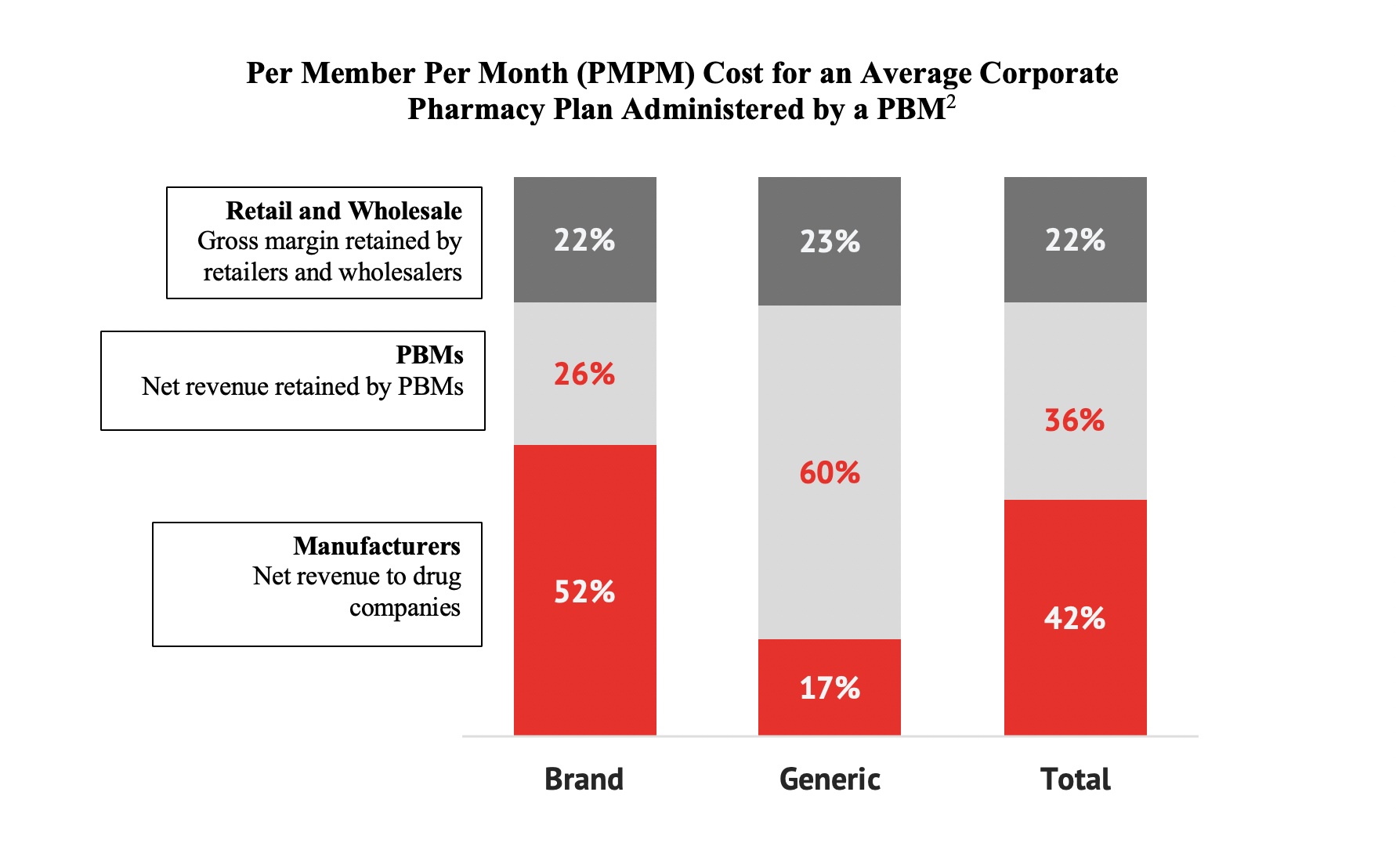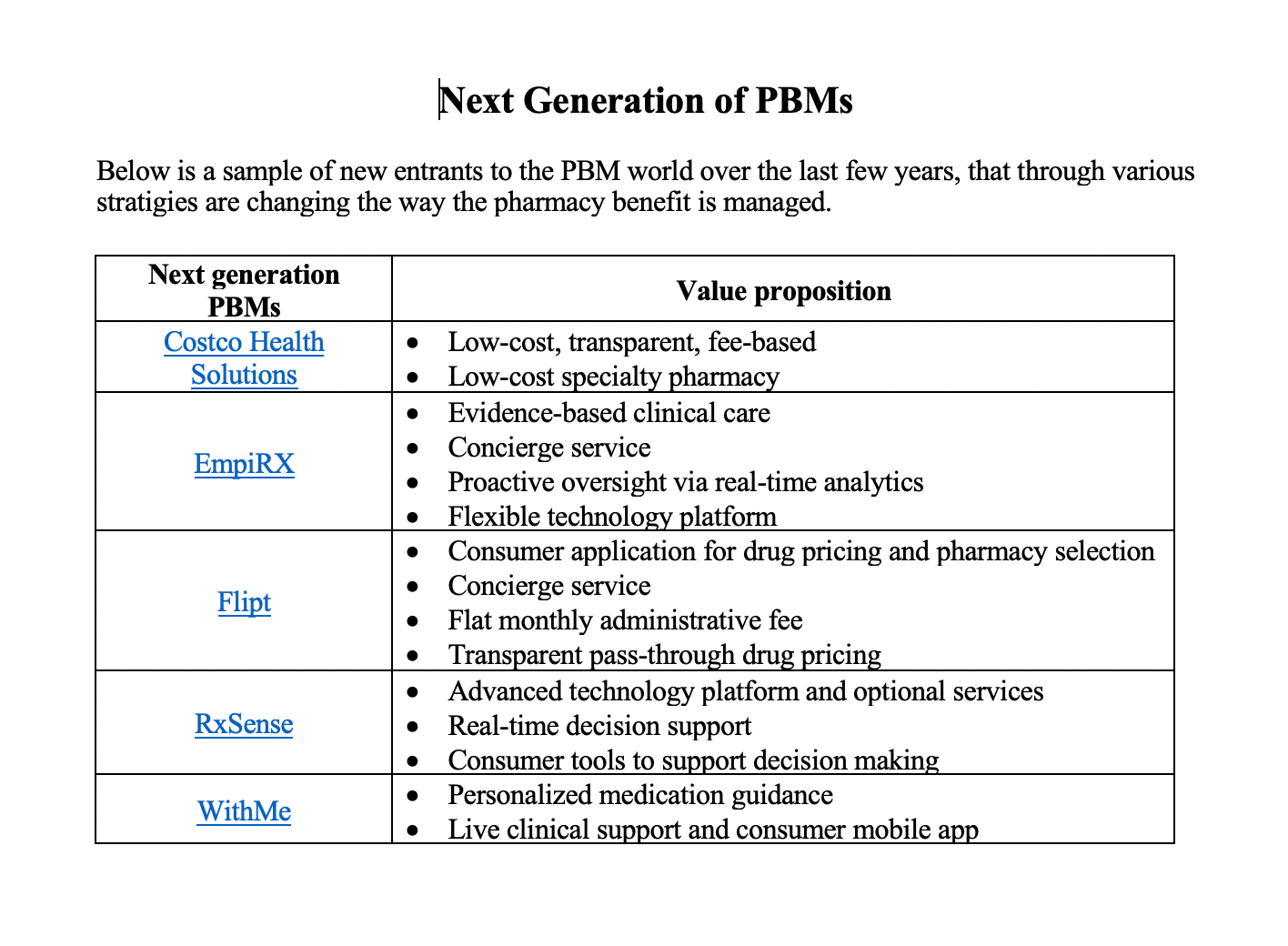The Next Generation of PBMs: New Technology, Simpler Business Model and More Transparency
Next generation PBMs like Flipt and RxSense are challenging the "old guard" PBMs that control three-quarters of the market.
Introduction
The COVID-19 pandemic has had a deep and profound impact on American businesses both large and small. As the country inches back to a “new normal,” business leaders have to deal with the cost of healthcare as a significant issue to their bottom line. Managing pharmaceutical costs will continue to be a major priority for employers.
Perry Cohen, CEO, The Pharmacy Group

During the last few years, employers, patients, pharmacies, pharmaceutical companies and the government have become “fed up” with the PBM cartel that exists in the marketplace. The “old guard” PBMshave been reinventing themselves through mergers and acquisitions. Promises of lowering drug costs have not materialized. New PBM entrants have emerged to bring new technology, a simpler business model, and more transparency. I propose to lay out a road map of where we are today and a guide to the market dynamics in the making.
PBM background
The PBM industry began in the 1990s to meet the needs of the employer-based health benefit market. Today they are at the center of the pharmaceutical supply chain, acting as intermediaries between payers, pharmaceutical companies and pharmacies.
PBMs are responsible for processing the majorityof the six billion prescriptions written in the United States by prescribers annually. As part of that, PBMs:
- Process pharmacy claims
- Obtain discounts from pharmacies
- Negotiate rebates from pharmaceutical companies
- Develop drug lists for formulary management
- Perform drug utilization management
To be reimbursed for their services, PBMs collect a variety of service fees. These fees can be administrated through traditional pricing or transparent pricing.
Traditional pricing benefits the PBM because it charges for each activity separately and allows for the PBM to have “spread pricing” on the pharmacy claims payment.
Transparent pricing is a newer model where the PBM passes through 100% of the discounts it receives from pharmacies and pharmaceutical companies.The PBM charges a fixed, per-patient per-month fee for all services (administrative and clinical).
Transparent pricing is not necessarily a new phenomenon. PBMs such as Navitus promoted this model in the early 2000s. As PBMs face increasing scrutiny from traditional spread pricing models and the margins afforded to rebates from pharmaceutical companies, many traditional PBMs are implementing different contracting strategies.
Rebates have also served as a source of revenue for PBMs whereby the rebate is shared with the plan sponsor. Over time this has become somewhat ofa controversial revenue stream.
Two of the large PBMs have created group purchasing organizations to presumeably/potentially “hide” the fees they make from pharmaceutical companies.
Current issues and trends
Constituents across the value chain of delivery and financing of healthcare are using both traditional and innovative approaches to redefine their position in the market. Traditional industry approaches such as obtaining scale advantage have been happening over the past several years. Several large mega-mergers have consolidated market share. The three largest PBMs — UnitedHealthcare’s Optum Rx, CVS Caremark/Aetna, and Cigna/Express Scripts — now account for more than three-quarters of the PBM market in the United States.
Consolidation has also occurred in the retail pharmacy sector where most of the stand-alone specialty pharmacies have been taken over by PBMs, payers or larger retail chains — all hoping to gain bargaining leverage in negotiating drug prices with pharmaceutical companies. In 2018, CVS acquired five specialty pharmacies: Apothecary By Design, Central Drugs, EncompassRx, EntrustRx, and SimplicyRx).
Industry consolidation is always a “make or buy” decision. In an effort to thwart some of this consolidation some payers are eliminating the PBM as an intermediary and developing their own internal capability. In October of 2017, Anthem announced that it would not renew its contract with Express Scripts and subsequently launched its own PBM, IngenioRx.
This concentration of market position has garnered “unwanted” attention of policy makers (at both the state and federal level) as well as employers and consumers. Both of these groups are concerned that drug prices continue to rise faster than inflation.
Issues facing employers
Employer-sponsored health insurance covers over 50% of the nonelderly population, which works out to about 153 million people in total. The average annual premiums for employer-sponsored health insurance in 2019 were $7,188 for single coverage and $20,576 for family coverage. At the same time wages rose 3.4% and inflation increased at 2%.[1]
Over a 10-year period the increases have been substantial:

As a result of these dramatic increase in premiums, there has been a focus by PBMs on addressing employer issues.
Embedded within these healthcare cost increases are the cost of medictions. The table below indicates by drug type the gross margin or net revenue attributed to each entity in the distribution of medication to the member (employee). Across the board, the logistical enterprises that manage the distribution of drugs receive a consistent share of the per member cost. In the case of brand drugs, manufacturers retain a substantial percentage largely due to the proprietary and patent protections attributed to these drugs. PBMs gain a portion largely due to rebates that are not always remitted to the plan administrator. In the case of generic drugs where there is greater competition among manufactures the revenues are much less, but PBMs continue to retain a substantial amount. Overall, it is estimated that this results in an extra cost to the system in excess of $100 billion.

[2] Based on 2016 and 2017 claims data for >200,000 employees and published information from major PBMs and industry reports.
New entrants
Below is a list of some of new entrants to the PBM world over the last few years that through various stratigies are changing the way the pharmacy benefit is managed.

Alternative pricing strategies
Because of the high-cost of new drug therapies, especially specialty drugs, an alternative is value-based contracting also referred to as outcomes-based contracting. Pricing is based upon predetermined patient measures or patient outcomes rather than a set cost. This places a level of risk on the drug manufacturer. Drugs utilized to treat hematological disorders and cancer are currently the primary therapeutic areas where value-based contracts are in place.
Staggered-payment plans and pay-for-performance contracts are two other strategies used between pharmaceutical companies and the PBM. These will be especially important as more cell and gene therapies come to market due to the high cost of these therapies.
In order to be successful, these alternative pricing strategies require stakeholder collaboration on data access and analytics to measure effectiveness.
Alternative medication delivery systems
Compliance with medication regimens has long been recognized as being important to the overall health of patients with acute and chronic diseases. Adherence to chronic medications has been estimated to only be about 50%, while it is reported to be even less for acute medications. A relatively new company that was founded to improve compliance is PillPack. Since PillPack was founded in 2013 several other companies have entered this specific marketplace. Pillpack was acquired by Amazon in 2018 and is now the cornerstone of “Amazon pharmacy”.
Digital health solutions
Digital health solutions such as mobile apps, patient portals, and care team dashboards are proliferating rapidly. By one estimate, the U.S. investment in such electronic products will reach $410 billion by the end of 2020. Pragmatic digital health solutions improve patient care, make clinical teams more efficient, and reduce costs. PBMs are implementing a number of innovative solutions. CVS Health has rolled out vendor benefit management (VBM) as a new service that enables payors to easily onboard and manage third-party vendors that provide both digital and non-digital solutions. The PBM has included Big Health’s Sleepio application is this program. Express Scripts released a digital formulary with the goal of providing 15 digital health programs to its members, starting in January 2020.
Summary
The world of pharmacy benefit management will change dramatically over the next five years.
Here are the three areas to watch:
- New Technology. The latest information technology will allow the consumer to access information about drug pricing, benefits, and pharmacy selection in real time which will enable them to save time and money when buying prescription drugs.
- Simpler Business Model. Fixed “all-inclusive” administrative fees will ensure that employers realize 100% of the savings from their PBM.
- More Transparency. Transparent pricing will help employers know where the drug dollars are being spent and saved.
Unrealistic Portrayals of Cardiac Arrest in Contemporary Film | ACC 2025
March 31st 2025Cardiac arrests in contemporary film are largely inaccurate when it comes to survival rate and etiology, according to a poster presented today at the American College of Cardiology conference held March 29 to 31 in Chicago.
Read More
Breaking Down Health Plans, HSAs, AI With Paul Fronstin of EBRI
November 19th 2024Featured in this latest episode of Tuning In to the C-Suite podcast is Paul Fronstin, director of health benefits research at EBRI, who shed light on the evolving landscape of health benefits with editors of Managed Healthcare Executive.
Listen
In this latest episode of Tuning In to the C-Suite podcast, Briana Contreras, an editor with MHE had the pleasure of meeting Loren McCaghy, director of consulting, health and consumer engagement and product insight at Accenture, to discuss the organization's latest report on U.S. consumers switching healthcare providers and insurance payers.
Listen
Winrevair Reduced Risk of Morbidity and Mortality by 76% in PAH | ACC 2025
March 31st 2025In the ZENITH trial, Winrevair was evaluated based on a composite endpoint of all-cause death, lung transplantation or disease-related hospitalization for patients with pulmonary arterial hypertension.
Read More
Clopidogrel Beat Aspirin in Preventing Heart Attacks After PCI | ACC 2025
March 31st 2025Clopidogrel monotherapy may be an alternative to aspirin for prevention of cardiac events in high-risk patients after percutaneous coronary intervention, according to a new study presented at ACC 2025.
Read More